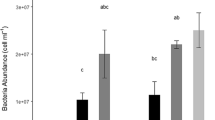Abstract
Methylamine (CH3NH +3 ) appeared to utilize the same transport mechanism as ammonium (NH +4 ) to enter cells ofNitrosococcus oceanus. Methylamine uptake did not show clear evidence of saturable kinetics and was not fully saturated at 20 mM. Assimilated CH3NH +3 was not incorporated into macromolecular constituents, but inhibited rates of nitrification, chemoautotrophic CO2 fixation and growth. The degree of inhibition was dependent on the relative concentrations of NH +4 and CH3NH +3 . Rates of CO2 fixation and growth were inhibited four times more than the rate of nitrification.
Similar content being viewed by others
References
Aleem MIH (1959) The physiology and chemoautotrophic metabolism ofNitrobacter agilis. Thesis, Cornell University, New York
Arst HN, Cove DJ (1969) Methylammonium resistance inAspergillus nidulans. J Bacteriol 98:1284–1293
Cook RJ, Anthony C (1978) The ammonia and methylamine active transport system ofAspergillus nidulans. J Gen Microbiol 109:265–274
Glover HE, Morris I (1979) Photosynthetic carboxylating enzymes in marine phytoplankton. Limnol Oceanog 24:510–519
Guillard RRL, Ryther JH (1962) Studies of marine planktonic diatoms. I.Cyclotella nana Hustedt andDetonula confervacea (Cleve)Gran. Can J Microbiol 8:229–239
Hackette SL, Syke GE, Burton C, Segel IH (1970) Characterization of an ammonium transport system in filamentous fungi with methylamonium-14C as the substrate. J Biol Chem 245:4241–4250
Kung HF, Wagner C (1970) Glutamethylamine — a new intermediate in the metabolism of methylamine. J Biol Chem 244:4136
McCarty RE (1980) Photosynthetic phosphorylation by chloroplasts of higher plants. Photochem Photobiol Rev 4:1–47
Morris I, Glover HE (1974) Questions on the mechanism of temperature adaptation in marine phytoplankton. Mar Biol 24:147–154
Morris I, Glover HE, Yentsch CS (1974) Products of photosynthesis by marine phytoplankton: The effect of environmental factors on the relative rates of protein synthesis. Mar Biol 27:1–10
Painter HA (1970) A review of literature on inorganic nitrogen metabolism in microorganisms. Wat Res 4:393–450
Pateman JA, Dunn E, Kinghorn JR, Forbes EC (1974) The transport of ammonium and methylammonium in wild type and mutant cells ofAspergillus nidulans. Molec Gen Genet 133:225–236
Pelley JL, Bannister TT (1979) Methylamine uptake in the green algaChlorella pyrenoidosa. J Phycol 151:110–112
Roon RJ, Even HL, Dunlop P, Larimore FL (1975) Methylamine and ammonia transport inSaccharomyces cerevisiae. J Bacteriol 122:502–509
Stevenson R, Silver S (1977) Methylammonium uptake byEscherichia coli: Evidence for a bacterial NH +4 transport system. Biochem Biophys Res Comm 75:1133–1139
Strickland JDH, Parsons TR (1972) A practical handbook of seawater analysis, 2nd Ed. Fish Res Bd Bull 167:310
Ulken A (1963) Die Herkunft des Nitris in der Elbe. Arch Hydrobiol 59:486–501
Watson SW, Mandel M (1971) Comparison of the morphology and nucleic acid composition of 27 strains of nitrifying bacteria. J Bact 107:563–569
Watson SW, Waterbury (1971) Characteristics of two marine nitrite oxidizing bacteriaNitrospina gracilis nov. gen. nov. sp. andNitrococcus mobilis nov. gen. nov. sp. Arch Mikrobiol 77:203–230
Wheeler PA (1978) Uptake of methylamine (an ammonium analogue) by the marine macrophyteMacrocystis pyrifera (Phaeophyta). J Phycol 15:12–17
Wheeler PA (1980) Use of methylammonium as an ammonium analogue in nitrogen transport and assimilation studies withCyclotella cryptica (Bacillariophyceae). J Phycol 16:328–334
Wheeler PA, Hellebust JA (1981) Uptake and concentration of alkylamines by a marine diatom. Effects of H+ and KY+ and implications for the transport and accumulation of weak bases. Plant Physiol 67:367–372
Author information
Authors and Affiliations
Rights and permissions
About this article
Cite this article
Glover, H.E. Methylamine, an inhibitor of ammonium oxidation and chemoautotrophic growth in the marine nitrifying bacteriumNitrosococcus oceanus . Arch. Microbiol. 132, 37–40 (1982). https://doi.org/10.1007/BF00690814
Received:
Accepted:
Issue Date:
DOI: https://doi.org/10.1007/BF00690814




